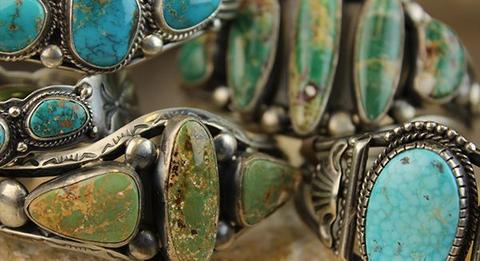Turquoise Doppelgängers: Why Do Some Mines Look Alike?

As you may know turquoise stones are like snowflakes, no two are the same. When turquoise is pulled from the earth it has a unique fingerprint. This is caused by unique elements that affect the stone during formation, such as host rock composition, elevation, pressure and temperature. This causes the stones to display variations of color and matrix patterns. Stones that are formed in the same mine are usually the product of similar host rock material and are exposed to similar environmental conditions. Common color and pattern variations can be observed being produced from specific mines. These stereotypical appearances are usually then associated with that mine. This is a very useful tool for identifying the origin of a turquoise stone. Experienced collectors and dealers in the industry can often see a turquoise stone and give you good idea what mine it came from, sometimes even the year it was mined.
Even though experts can get really good at identifying turquoise stones this way, it is almost impossible to be 100% accurate. Turquoise doppelgangers exist out there to fool us all. As turquoise veins run through the earth they hit inconsistent patches of rocks and other elements. These not only change the host stone composition, but also can affect the pressure or temperature. This causes variations or the stone appearance that can mimic other mines.
Here are some examples of some stones that look very much alike. Can you tell the difference?
In this first image some of the sets of stones are from the Royston Turquoise Mine and the other is from the Ajax mine. The greenish coloration is from the concentration of iron in the host material during formation.

This second image is a set of stones from the Candaleria mine and the other is from Lone mountain turquoise mine. The blue color is usually an indication for higher concentrations for aluminum during formation.

The final picture is an image of stones from the Royston mine and the Easter Blue turquoise mine. These mines are in very near in proximity to each other, both in the Royston district in Nevada. I wanted to note that the Royston mine was also used in the first picture and even though some of these stones came from the same mine they look very different.

To learn more about turquoise mines color and pattern variations please check out these links.









